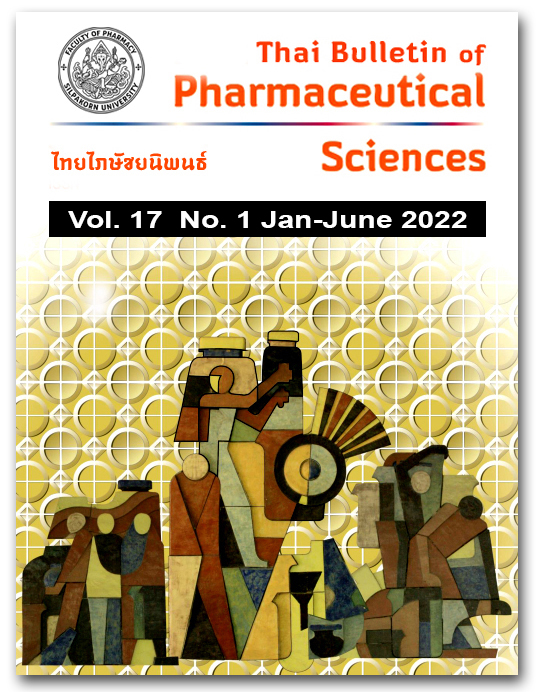ความเสี่ยงของการใช้ยาต้านโคลิเนอร์จิกกับการหกล้มในผู้ป่วยสูงอายุ: การศึกษาโคฮอร์ทแบบย้อนหลัง
DOI:
https://doi.org/10.69598/tbps.17.1.43-56คำสำคัญ:
ยาต้านโคลิเนอร์จิก, ผู้ป่วยสูงอายุ, การหกล้มบทคัดย่อ
ยาต้านโคลิเนอร์จิกก่อให้เกิดอาการไม่พึงประสงค์ทำให้เกิดอาการง่วงซึม ตาพร่ามัว และอื่น ๆ จนนำมาสู่การหกล้ม อย่างไรก็ตามยังไม่มีรายงานการศึกษาถึงความสัมพันธ์ของยาต้านโคลิเนอร์จิกกับการหกล้มในประเทศไทย การศึกษานี้มีวัตถุประสงค์เพื่อศึกษาอัตราอุบัติการณ์ และหาความสัมพันธ์ของยาต้านโคลิเนอร์จิกกับการหกล้ม โดยดำเนินการศึกษาโคฮอร์ทแบบย้อนหลัง จากข้อมูลเวชระเบียนอิเล็กทรอนิกส์ในผู้ป่วยอายุตั้งแต่ 65 ปีขึ้นไป แบ่งกลุ่มผู้ป่วยตามคะแนน Anticholinergic Cognitive Burden (ACB) ณ โรงพยาบาลวารินชำราบและโรงพยาบาลส่งเสริมสุขภาพตำบลเครือข่าย ระหว่างปี พ.ศ. 2553 ถึง พ.ศ. 2562 ติดตามการใช้ยาอย่างต่อเนื่องจนเกิดหกล้มครั้งแรก วิเคราะห์ข้อมูลอัตราอุบัติการณ์การหกล้ม และความสัมพันธ์ของการใช้ยาต้านโคลิเนอร์จิกกับการหกล้มโดยใช้Cox Proportional Hazard Regression Model มีผู้ป่วยในการศึกษา 16,624 ราย อายุเฉลี่ย 73.02±6.77 ปี ระยะเวลาติดตามเฉลี่ย 4.15±1.52 ปี พบอัตราอุบัติการณ์ของการหกล้มในกลุ่มที่ใช้ยาต้านโคลิเนอร์จิกและกลุ่มยาอื่น ๆ 60.80 และ 22.77 คนต่อ 1,000 คน-ปีตามลำดับ เมื่อจำแนกการใช้ยาตามคะแนนรวม ACB = 1 คะแนน, 2 - 3 คะแนน และ
≥ 4 คะแนน เปรียบเทียบกับกลุ่มควบคุม (ACB = 0 คะแนน) พบว่า Adjusted Hazard Ratio ของการหกล้มเพิ่มขึ้น 1.28 เท่า (95%CI 1.14 – 1.44, p<0.001), 1.83 เท่า (95%CI 1.61 – 2.09, p<0.001) และ 3.25 เท่า (95%CI2.71 – 3.89, p<0.001) ตามลำดับ การศึกษาพบยาต้านโคลิเนอร์จิกเพิ่มความเสี่ยงการหกล้มในผู้สูงอายุ หากมีการใช้ยาต่อเนื่องควรติดตามและประเมินความเสี่ยงดังกล่าว พร้อมทั้งให้ความรู้และคำแนะนำกับผู้ป่วยสูงอายุเพื่อเฝ้าระวังการหกล้มที่อาจเกิดขึ้นได้
เอกสารอ้างอิง
Population Division of United Nation [internet]. World population; 2019. [cited 2020 Jul 19]. Available from: http://www.un.org/esa/population
Ministry of Information and Communication Technology. The 2014 Survey of the older persons in Thailand 2014. Bangkok: Text and Journal Publication; 2014. (in Thai)
Office of the national Economic and Social development board. Population projections for Thailand 2010 - 2014. Bangkok: Thailand Standard Industrial Classification (TSIC); 2013. (in Thai)
Office of Promotion and Protection of Children Youth and the Elderly. Strategic Plan of the Office Promotion and Protection of Elderly; 2019. [cited 2020 Jul 19]. Available from: http://www.oppo.opp.go.th/info/strategy_2562. (in Thai)
Ruangritchankul S, Krairit O, Putthipokin K, Chansirikarnjana S, Assavapokee T, Sraium S. Polypharmacy among older adults in outpatient clinic, Internal Medicine Department, Ramathibodi Hospital. Thai J Toxicol. 2018;30;33(1):35-50.
Elliott RA. Problems with medication use in the elderly: an Australian perspective. J Pharm Prac res. 2006;36(1):58-66.
Hepler CD, Strand LM. Opportunities and responsibilities in pharmaceutical care. American J Hosp Pharm. 1990;1;47 (3):533-43.
Beuscart JB, Dupont C, Defebvre MM, Puisieux F. Potentially inappropriate medications (PIMs) and anticholinergic levels in the elderly: a population based study in a French region. Archives of gerontology and geriatrics. 2014;1;59(3):630-5.
Sura SD, Carnahan RM, Chen H, Aparasu RR. Prevalence and determinants of anticholinergic medication use in elderly dementia patients. Drugs & aging. 2013;1;30(10):837-44.
Bell J, Mezrani C, Blacker N, LeBlanc T, Frank O, Alderman CP, Rossi S, Rowett D, Shute R. Anticholinergic and sedative medicines: prescribing considerations for people with dementia. Aust Fam Physician. 2012;41(1/2):45-9.
Dauphinot V, Faure R, Omrani S, Goutelle S, Bourguignon L, Krolak-Salmon P, Mouchoux C. Exposure to anticholinergic and sedative drugs, risk of falls, and mortality: an elderly inpatient, multicenter cohort. J clin psychopharmacol. 2014;1;34(5):565-70.
Cross AJ, George J, Woodward MC, Ames D, Brodaty H, Wolfe R, Connors MH, Elliott RA. Potentially inappropriate medication, anticholinergic burden, and mortality in people attending memory clinics. J Alzheimers Dis. 2017;1;60(2):349-58.
O'Mahony D, O'Sullivan D, Byrne S, O'Connor MN, Ryan C, Gallagher P. STOPP/START criteria for potentially inappropriate prescribing in older people: version 2. Age ageing. 2015;1;44(2):213-8.
Kalisch Ellett LM, Pratt NL, Ramsay EN, Barratt JD, Roughead EE. Multiple anticholinergic medication use and risk of hospital admission for confusion or dementia. J Am Geriatr Soc. 2014;62(10): 1916-22.
StataCorp LP. Stata power exponential — Power analysis for a two-sample exponential test. Texas: A Stata Press Publication StataCorp LP. Retreived May. 2021;05:2021.
Tan MP, Tan GJ, Mat S, Luben RN, Wareham NJ, Khaw KT, Myint PK. Use of medications with anticholinergic properties and the long-term risk of hospitalization for falls and fractures in the EPIC-Norfolk Longitudinal Cohort Study. Drugs aging. 2020 Feb;37(2):105-14.
Lozano-Ortega G, Johnston KM, Cheung A, Wagg A, Campbell NL, Dmochowski RR, Ng DB. A review of published anticholinergic scales and measures and their applicability in database analyses. Arch Gerontol Geriatr. 2020;1;87:103885.
Boustani M, Campbell N, Munger S, Maidment I, Fox C. Impact of anticholinergics on the aging brain: a review and practical application. Aging Health. 2008;4(3):311–20.
Peters N. Antimuscarinic side-effects of anticholinergic medications in the elderly. Arch Intern Med. 1989;149:2414-20.
Squires P, Pahor M, Manini TM, Vouri S, Brown JD. Impact of anticholinergic medication burden on mobility and falls in the Lifestyle Interventions for Elders (LIFE) Study. J Clin Med. 2020;9(9):2989.
Valladales-Restrepo LF, Duran-Lengua M, Castro-Osorio EE, Machado-Alba JE. Consistency between anticholinergic burden scales in the elderly with fractures. Plos one. 2020 ;24;15(2):e0228532.
Delafuente J. Pharmacokinetic and pharmacodynamic alterations in the geriatric patient. Consult Pharm. 2008;1;23(4):324-34.
Rudolph JL, Salow MJ, Angelini MC, McGlinchey RE. The anticholinergic risk scale and anticholinergic adverse effects in older persons. Arch Intern Med. 2008;10;168(5):508-13.
Division of Non communicable Diseases. Forecasting reports of falls among the elderly (age 60 years and older) in Thailand 2017 – 2021. Nonthaburi: Department of disease control Ministry of Public Health; 2017. (in Thai)
Zia A, Kamaruzzaman S, Myint PK, Tan MP. Anticholinergic burden is associated with recurrent and injurious falls in older individuals. Maturitas. 2016;1;84:32-7.



